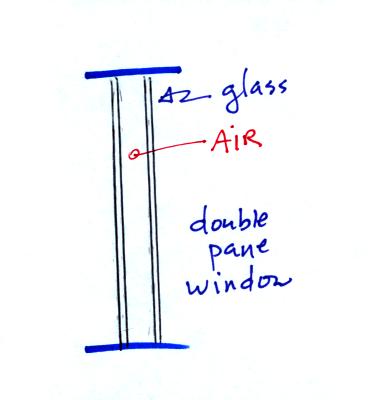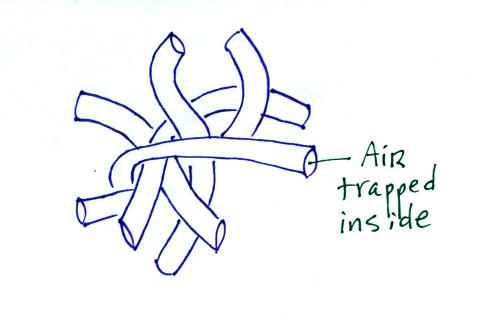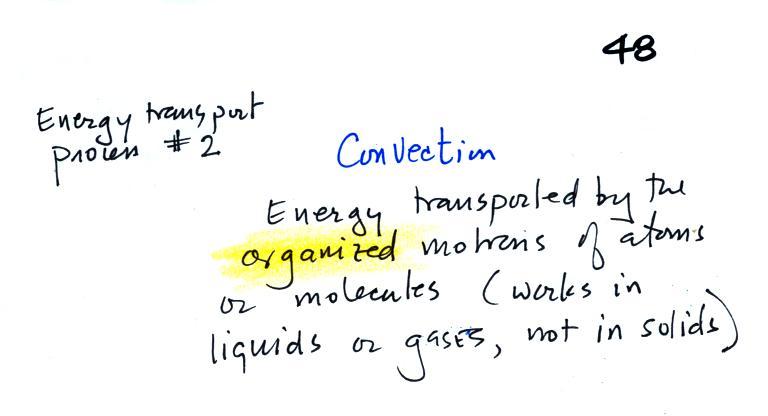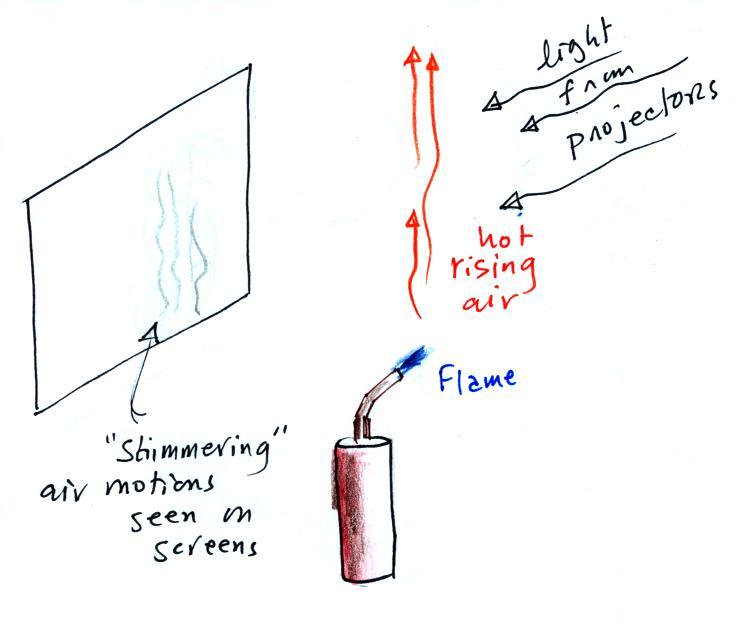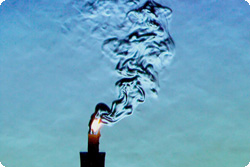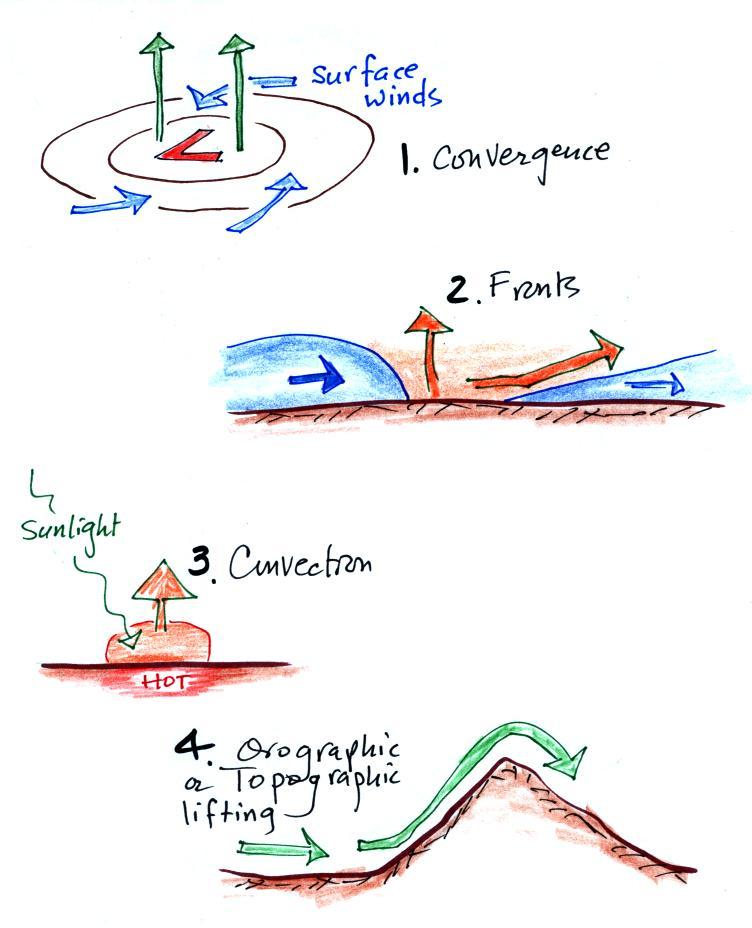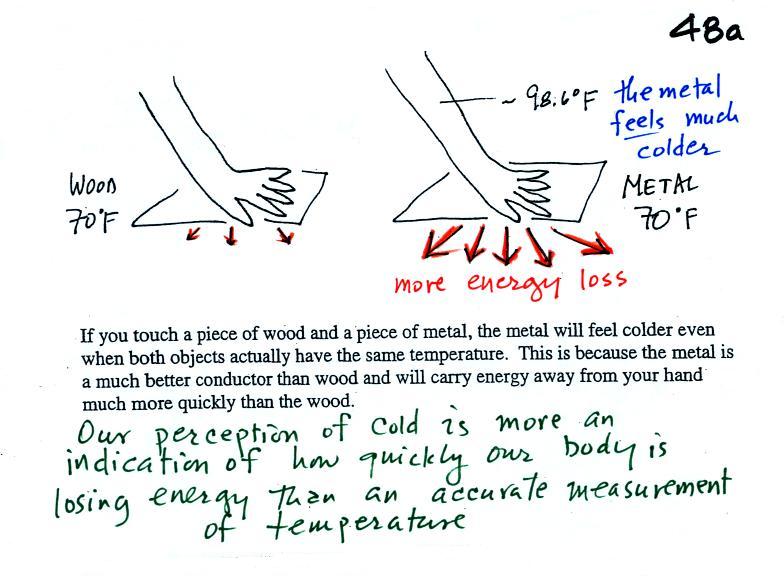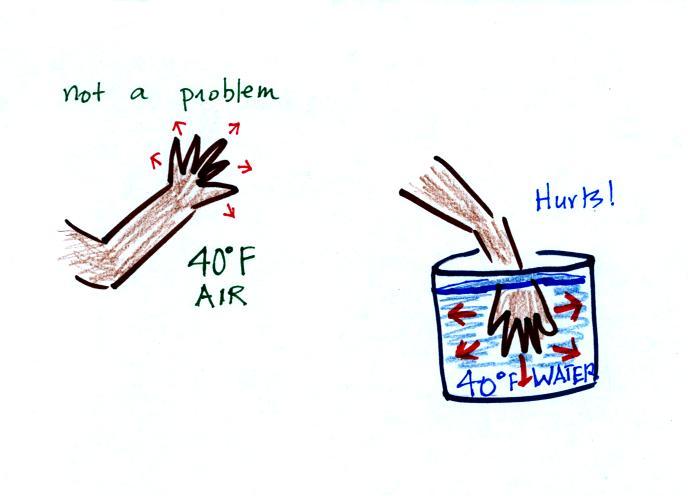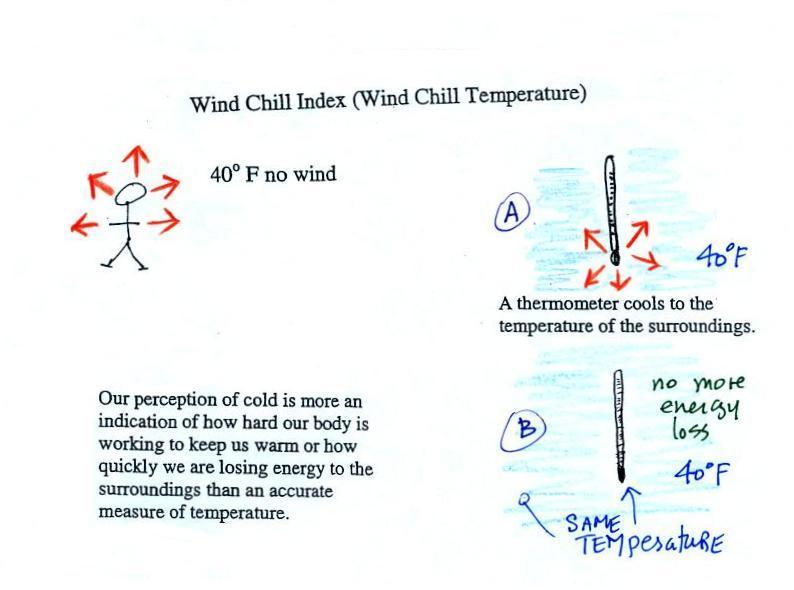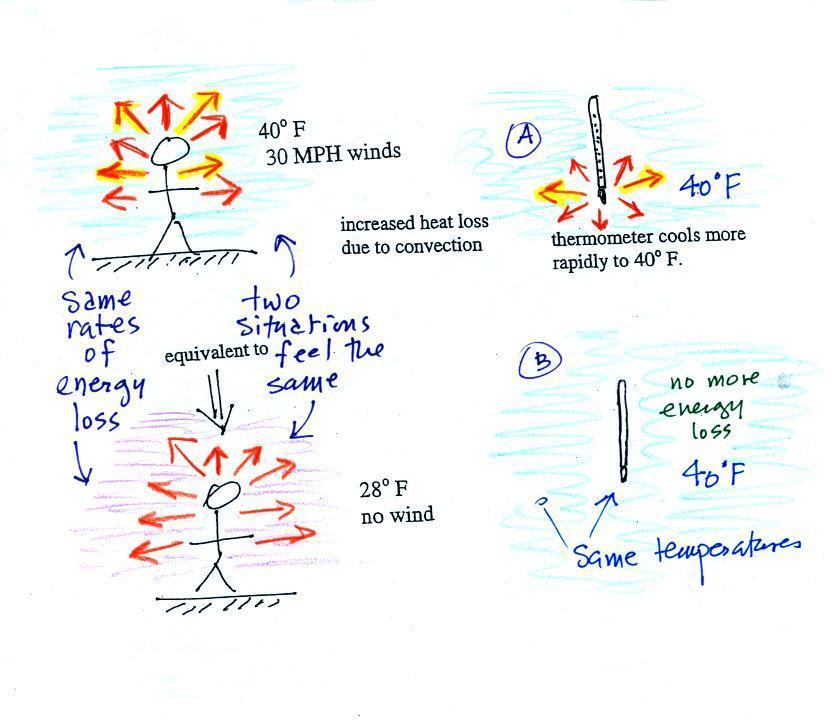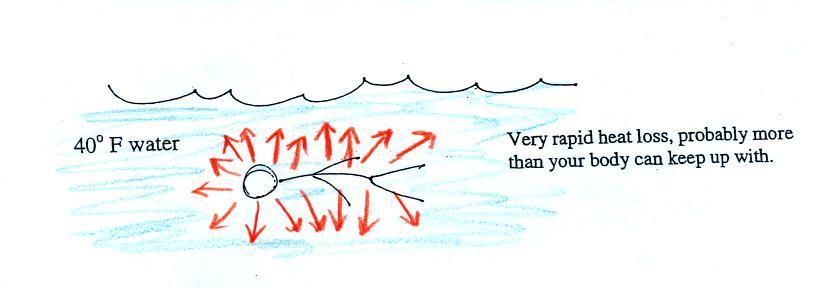Monday Oct. 1, 2012
click here to
download today's notes in a more printer friendly format
Songs from the Beatles are often short so I was able to squeeze 4
in before class today. You heard "I'll
Cry Instead", "Things
We
Said
Today", "You
Can't Do That",
and "I'll Be Back"
all
from
the
"A
Hard
Day's
Night"
album.
The Surface Weather Map optional assignment was collected
today. I'll try to get those graded and returned to you this week.
The Upper Level
Charts optional assignment is due at the beginning of class on
Wednesday.
Conduction
is the first of four energy transport processes
that we
will cover (and the least important transport process in the
atmosphere). The figure below illustrates this process. I
heated up the end of a piece of copper tubing just so you could
visualize a hot object. If you held the object in air it would
slowly lose energy by conduction and cool off.
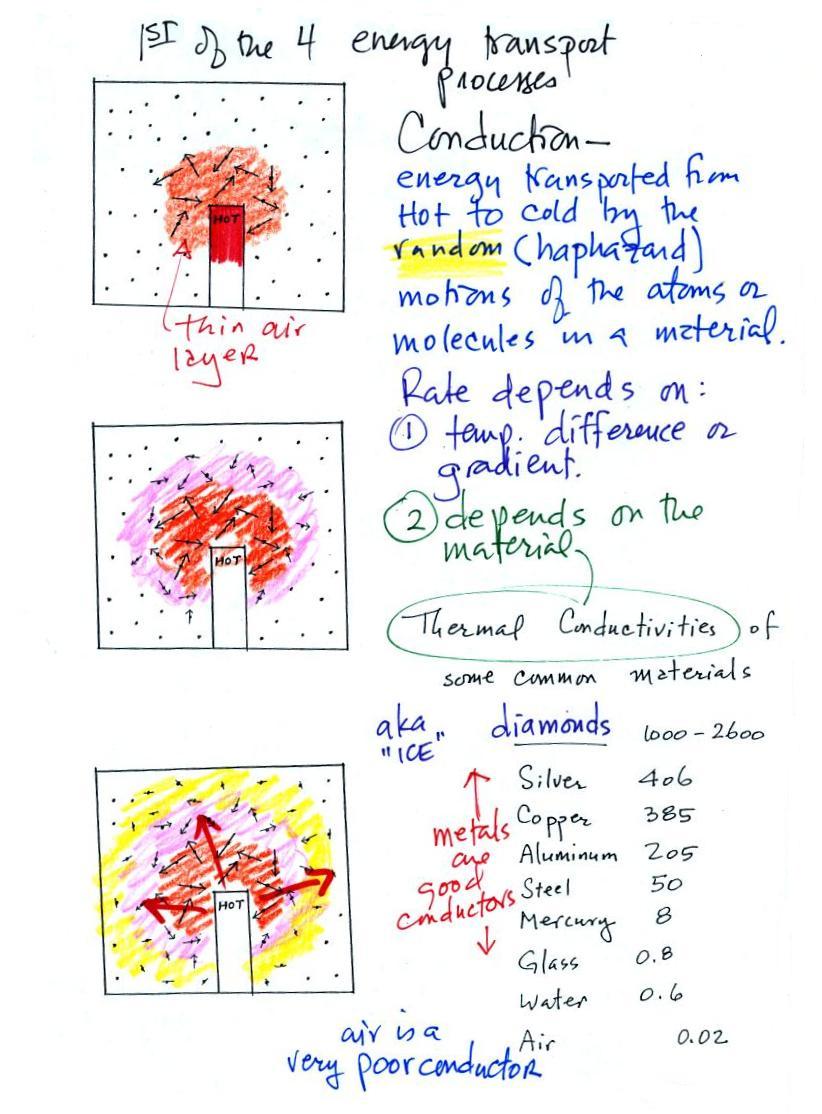
How does that happen? In
the top picture some of the
atoms or molecules near the
hot object have collided with the object and picked up energy from the
object. This is reflected by the increased speed
of motion or increased kinetic energy of these molecules or
atoms (these guys are colored orange).
In the middle picture the
initial bunch of
energetic molecules have
collided with some of their neighbors and shared energy with
them (these are pink). The neighbor molecules have gained
energy though they don't
have as much energy as the molecules next to the hot object.
In
the third picture molecules further out (yellow) have now gained
some energy. The random motions and collisions
between molecules
is carrying energy from the hot object out into the colder surrounding
air.
Conduction transports energy from hot to cold. The
rate
of
energy
transport
depends
first
on
the
temperature
gradient
or
temperature
difference
between
the hot object and the
cooler surroundings. If the object in the picture
had been warm rather
than hot, less energy would flow and energy would flow at a slower into
the surrounding air.
The rate of
energy transport also depends on the material transporting energy (air
in the example
above). Thermal
conductivities of some common materials are listed. Air is a very
poor conductor of energy and is
generally regarded as an
insulator.
Water is a little bit better conductor. Metals
are generally very good conductors (cooking pans are often made of
stainless steel but have aluminum or copper bottoms to evenly spread
out heat when placed on a stove). Diamond has a very high
thermal conductivity (apparently the highest of all known
solids). Diamonds are sometimes called "ice."
They feel cold when you touch them. The cold feeling is due to
the fact that they conduct energy very quickly away from your warm
fingers when you touch them.
I brought a propane torch to class to demonstrate the behavior of
materials with different thermal conductivities.
A piece of copper tubing is held in the flame in the picture at
left. Copper is a good conductor. Energy is transported
from the flame by the copper and you must grab the tubing several
inches from the end to keep from burning your fingers. Part of a
glass graduated cylinder is held in the flame in the center
picture. You could comfortably hold onto the cylinder just a
couple of inches from the end because glass is a relatively poor
conductor. The end of the glass tubing got so hot that it began
to glow (its is emitting radiant energy, the 4th of the energy
transport processes we will discuss). Air is such a poor
conductor that it is safe to hold your finger just half an inch from
the hot flame and still not feel any heat coming from the flame.
Transport of energy by conduction is similar to the
transport of a strong smell throughout a classroom by diffusion.
Small eddies of wind in the classroom blow in random directions and
move smells throughout the room. For a demonstration you need
something that has a strong smell but is safe to breathe.
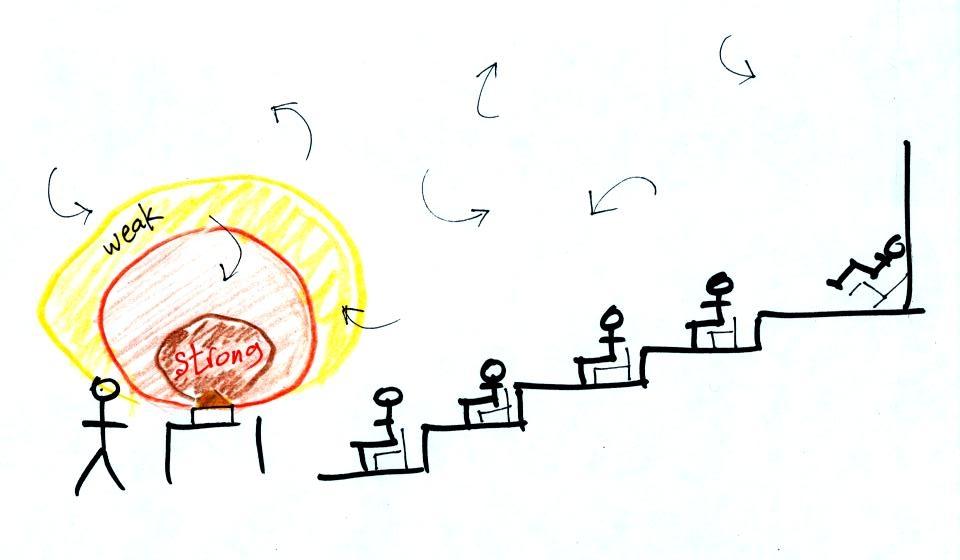
I chose curry powder.
With time I was hoping the smell would
spread
throughout the room. But ILC 150 is too large and the ventilation
system is too
good. It
quickly replaces air in the classroom with fresh air from outside (if
mercury were ever spilled I'm guessing the ventilation system won't
allow the vapor to build up the dangerous levels). Still we'll
add another element to this demonstration and try to spread the curry
further into the room.
Because
air has such a low thermal conductivity it is often used as an
insulator. It is important, however, to keep the air trapped in
small pockets or small volumes so that it isn't able to move and
transport energy by convection (we'll look at convection
shortly). Here are some examples of
insulators that use air:
Foam is
filled with lots of small air bubbles, they're what provides the
insulation.
Thin
insulating layer of air in a double
pane window. I don't have double pane
windows in my house. As a matter of fact
I leave a window open so the cats can get in and
out of the house (that's not particularly energy
efficient). And the stray cats have found out about it and come
in to eat my cat's food). Maybe
sprinkling curry powder on the carpet will keep the stray cats out.
Hollow fibers
(Hollofil) filled with air used in
sleeping
bags and
winter coats. Goose feathers
(goosedown) work in a similar way. I thought of another example
after class, Fiberglas insulation. It works so well as an
insulator first because it is glass which has low thermal conductivity
and also because it traps lots of little pockets of air.
Convection
was the next energy transport process we had a look at.
Rather
than moving about randomly, the atoms or molecules move together as a
group (organized motion). Convection works in liquids and gases
but not
solids (the atoms or molecules in a solid can't move freely). That's something I
forgot to mention in class.
I heated up the piece of copper tubing again. How would you
cool it off? The first thing that might come to mind is to blow
on it. That's forced convection.
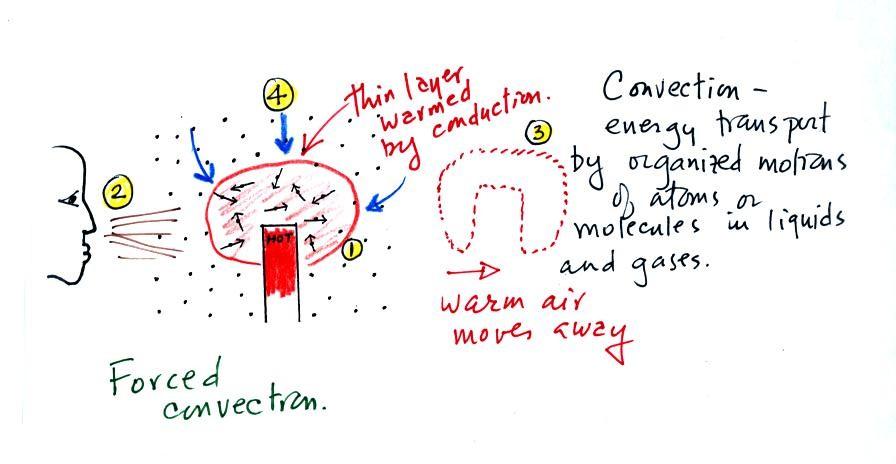
At Point 1 in the picture above a
thin layer of air
surrounding a hot object has
been
heated by conduction. Then at Point 2 a person is blowing the blob of
warm air
off to the right. The warm air molecules are moving away at Point
3 from the
hot object together as a group (that's the organized part of the
motion). At Point 4 cooler air moves in and surrounds the hot
object and the whole process repeats itself.
To try to spread the curry smell further into the room, I put a
small fan behind the curry powder.
And actually you don't need to force convection, it will often happen
on its own.
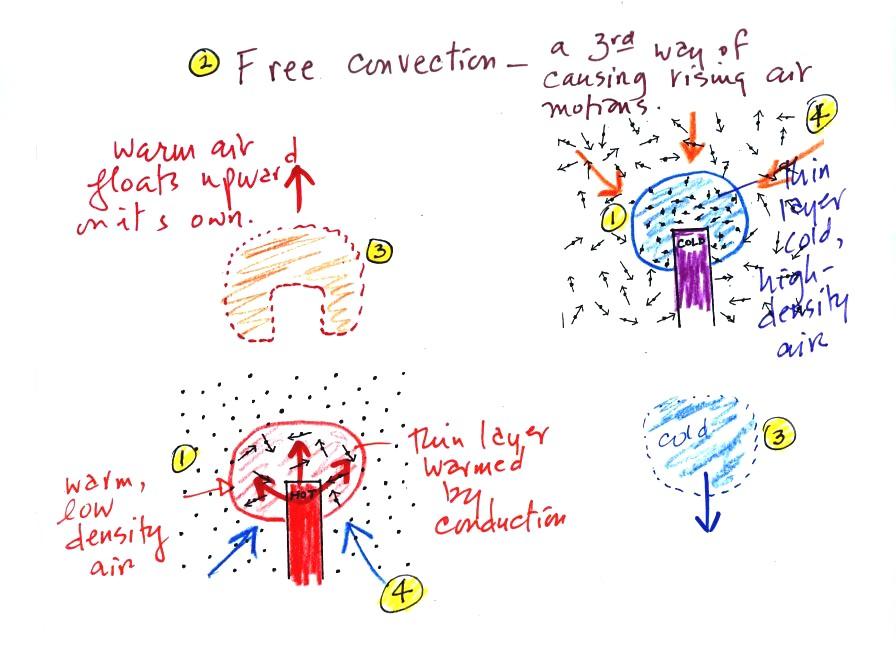
A thin layer of air at Point 1 in
the figure above (lower
left) is
heated by conduction. Then because hot air is also
low density air, it actually isn't necessary to blow on the hot object,
the
warm air will rise by itself (Point 3). Energy is being
transported away
from the hot object into the cooler surrounding air. This is
called free convection. Cooler air moves in to take the place of
the rising air at Point 4 and the cycle repeats itself.
The example at upper right is also
free convection. Room temperature air in contact with a cold
object loses energy and becomes cold high density air. The
sinking
air motions that would be found around a cold object have the effect of
transporting energy from the room temperature surroundings to the
colder object.
In both examples of free convection, energy is being transported
from
hot toward cold.
I could put my finger alongside the flame from the propane torch
without any problem. There's very little energy transported
sideways through air by conduction. I'm very
careful
if I put my fingers or
hand above the torch. That's
because there's a lot of very
hot
air rising from the torch. This is energy transport by
convection.
I held the torch in front of one of the screens and you
could barely see some of the shimmering rising air from the torch (see
sketch at left). Schlieren photography can capture this hot,
rising, low-density air (the photo above at right, not shown in class,
is
from
this
site was taken by Gary Settles from Penn State University.
You'll find some other examples if you click on the link).
Free convection is a 3rd way of causing rising air motions
(together with convergence into centers of low pressure and
fronts). They're sketched below together with the 4th
process.
Wind is blowing up and over an obstacle in the fourth sketch
above. This is orographic or topographic lifting. Clouds
would be found on the upslope side of the mountain. The sinking
air on the downwind side warms and keeps clouds from forming. One
side of a moutain can be green and lush because of abundant
precipitation. The other side could be dry and covered less and
different vegetation. This is the rainshadow effect and will come
up again later in the course.
Now some fairly practical applications, I think, of what we have
learned about conductive and
convective energy transport. Energy transport really does show up
in a lot more everyday real life situations than you might expect.
Note first of all there is a temperature difference between
your hand and a room temperature (70 F) object. Energy will flow
from your warm
hand to the colder object. Metals are better conductors than
wood. If you touch a
piece of
70 F metal it will feel much colder than a piece of 70 F wood, even
though they both have the same temperature. A
piece
of 70 F diamond would feel even colder because it is an even better
conductor
than metal. A piece of aluminum and a piece of wood
(oak) were passed around class so that you could check this out for
yourself.
Something that feels cold may not be as
cold as it seems. Our perception of cold is more an
indication of how
quickly our body or hand or whatever is losing energy than a reliable
measurement of
temperature.
Here's a similar situation.
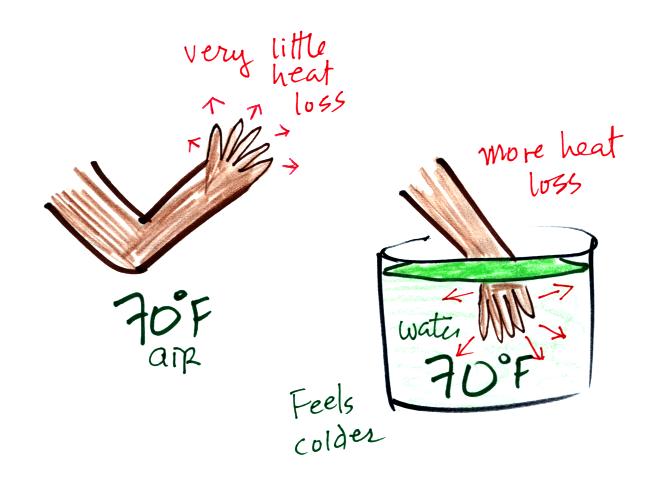
It's pleasant
standing outside on a nice day in 70 F air. But if
you jump into 70 F pool water you
will
feel cold, at least until you "get used" to the water temperature (your
body might reduce blood flow to your extremeties and skin to try to
reduce energy loss).
Air is a poor conductor. If you go out in
40 F
weather you will feel colder largely because there is a larger
temperature difference between you and your surroundings (and
temperature difference is one of the factors that affect rate of energy
transport by conduction).
If you stick your hand
into a bucket of 40 F water (I probably shouldn't, but I will suggest
you try this), it will feel very
cold (your hand will
actually soon begin to hurt). Water is a much better conductor
than air. Energy flows much more rapidly from your hand into the
cold water. Successive application of hot and then cold is
sometimes used to
treat arthritis
joint
pain.
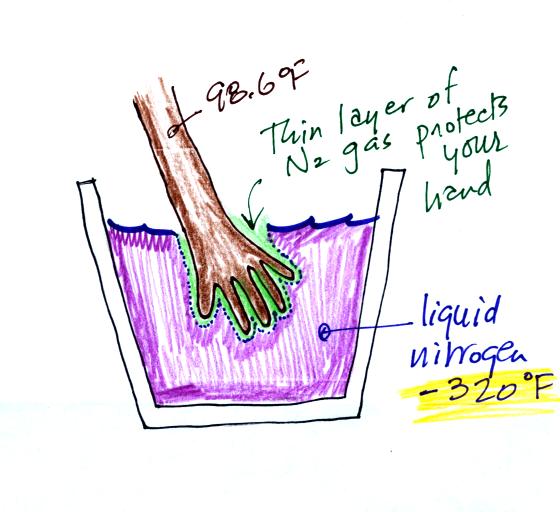
Wind chill is a good example of energy
transport by convection and. As a matter of fact I'm hoping that
if I
mention energy transport by convection that you'll first think of wind
chill. It is also a reminder that our
perception of cold is an indication of how quickly our body is
losing energy rather than an accurate measurement of temperature.
Your body works hard to keep its core temperature around
98.6 F. If you go outside on a 40 F day (calm winds)
you will
feel
cool; your
body is losing energy to the colder surroundings (by conduction
mainly). Your body will be able to keep you warm for a little
while anyway (perhaps indefinitely, I don't know). The 5 arrows
represent the rate at which your body is losing energy.
A thermometer
behaves differently, it is supposed to cool to the temperature of the
surroundings. Once it reaches 40 F and has the same temperature
as the air around it the energy loss will stop. If your body
cools to 40 F you will probably die.
If you go outside on a 40 F day with 30 MPH winds your
body
will lose
energy at a more rapid rate (because convection together with
conduction are transporting energy away from your body). Note the
additional arrows drawn on the figures above indicating the greater
heat loss. This
higher rate of energy loss will make it feel colder
than a 40
F day
with calm winds.
Actually, in terms of the rate at which your
body loses energy, the windy 40 F day would feel the same as a 28
F day without any wind. Your body is losing energy at the same
rate in both
cases (9 arrows in both cases). The combination 40 F and 30 MPH
winds results in a wind
chill temperature of 28 F.
The thermometer will again cool to the
temperature of its surroundings, it will just cool more quickly on a
windy day. Once the thermometer reaches 40 F there won't be any
additional energy flow or further cooling. The
thermometer would measure 40 F on both the calm and the windy day.
Standing outside on a 40 F day is not an immediate life
threatening
situation. Falling into 40 F water is, you'd last about 30
minutes (you'd probably go unconscious before that and die by drowning).
Energy will be conducted away from your body more quickly
than
your
body can replace it. Your core body temperature will drop and
bring on hypothermia.
Be
sure
not
to
confuse
hypothermia
with
hyperthermia
which
can bring on
heatstroke and is a serious outdoors risk in S.
Arizona in the summer.





